Next week the Ohio History Connection opens a new exhibit about extinct and endangered animals, titled “Going, Going, Gone? Endangered and Extinct Species”. One small part of that exhibit deals with people making a difference, and one of those people is retired high school teacher and herpetologist Doug Wynn.
Doug has spent many years studying Ohios Timber Rattlesnakes – a State Endangered species. His studies and the efforts of those working with him continue to provide vital information about these interesting snakes. The life history and habitat information gained provides critical information that can guide management decisions for the Ohio Division of Wildlife and the Ohio Division of Forestry.
This past Wednesday I had the privilege of joining Doug and several other biologists in the field in Southern Ohio to look for rattlesnakes into which he has inserted radio-telemetry transmitters. Four such snakes are checked once or twice a week by Dennis Case and his wife Rita. Angie Boyer, an endangered species biologist with the U.S. Fish and Wildlife Service, had joined us too, and Dennis gave her instructions on using the telemetry receiver to track down a rattlesnake. Our group included Doug, Dennis, Rita, Angie plus Dougs long-time field companion John Birkhimer and myself.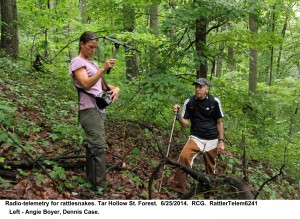
After about an hour of climbing up and down steep forest hillsides following the transmitter’s signal, we finally spotted the targeted Timber Rattler. It was a beautiful, yellow phase male which apparently had just molted during the previous week since last seen. It was sitting in the open on the hillside and was very, very calm. Previously, when captured to surgically insert the transmitter, it measured at 54 inches long and weighed nearly five pounds – much larger than a “typical” Timber Rattlesnake – but still smaller than a record 72 inch long one recorded elsewhere in the literature.
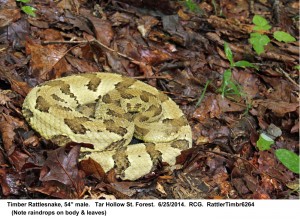
Timber Rattlesnake, 54″ male.
We watched this snake for at least 20 minutes during which time it never moved a muscle, and flicked its tongue out only once. It was certainly a lot calmer than we were! I snapped a ton of photos and regretted not having my tripod with me. We had been working with on-again, off-again rain showers all morning, and while it was not raining while we were with the snake, the sky was still dark. Notice the raindrops sitting on top of the snake!
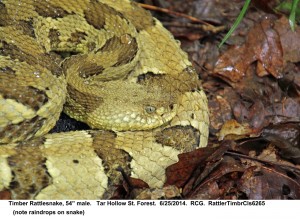
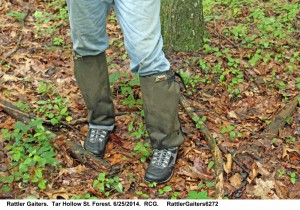
So why bother studying and trying to conserve rattlesnakes? Some folks would much rather see them totally eliminated after all. I feel sorry for people who feel that way, as all snakes – even the venomous ones – are an important part of the ecology of a natural ecosystem. Furthermore, they are beautiful and fascinating creatures. Knowing they are “out there” when you hike in the woods makes the trip more exciting and makes the woods seem wilder. We don’t always know all the benefits of any particular species–but we do know that research on snake venom promises insight into several important medical advances. The famed National Geographic photographer, Joel Sartore (see www.photoark.com ) sums it quite well, saying: “It is folly to think that we can destroy one species and ecosystem after another and not affect humanity. When we save species, we’re actually saving ourselves.”
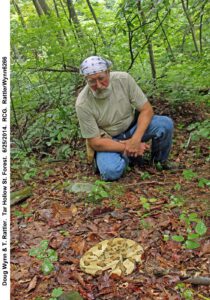
The Timber Rattlesnake still survives in a small handful of places in southern Ohio. Thanks to people like Doug Wynn, its not gone yet. But we are losing species at an alarming rate. Please come and see the exhibit at the Ohio History Center “Going, Going, Gone?” and learn more about species that have been lost, species that are still hanging on, and also success stories about species that have been saved from extinction. The exhibit opens to the public on Wednesday, July 2nd. Museum hours and admission fees can be found at:
www.ohiohistory.org.Bob Glotzhober
Curator Emeritus of Natural History